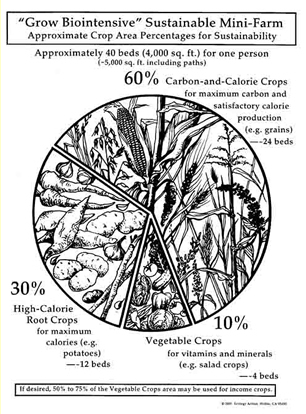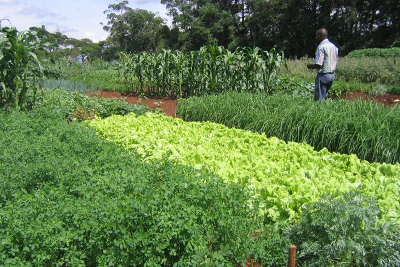
Grow Biointensive garden divisions
 One of Jeavons' goals in his
Grow Biointensive garden is to create a closed loop, growing all of his
compost on-farm. Finding enough compost can be an issue for
sustainable gardeners since you won't get nearly enough organic matter
from your garden "waste" to feed next year's plants. Jeavons
solves that problem by focusing a huge proportion of his growing area
on grains that not only produce a lot of calories, but also build
carbon for the compost pile.
One of Jeavons' goals in his
Grow Biointensive garden is to create a closed loop, growing all of his
compost on-farm. Finding enough compost can be an issue for
sustainable gardeners since you won't get nearly enough organic matter
from your garden "waste" to feed next year's plants. Jeavons
solves that problem by focusing a huge proportion of his growing area
on grains that not only produce a lot of calories, but also build
carbon for the compost pile.
The diagram to the
right, from Ecology
Action's website,
shows how the group breaks their farm down into categories:
- 60% grains (wheat, rye, oats, barley, triticale, corn, sorghum,
amaranth, quinoa, pearl millet, and also non-grains such as fava beans,
sunflowers, filberts, and grapes)
- 30% roots (leeks, garlic, parsnips, sweet potatoes, salsify,
potatoes, Jerusalem artichokes)
- 10% vegetables (everything else, including lower-yielding roots like turnips and onions)
Looking at Jeavons
numbers, I'm a bit shocked by his ratios --- I'd be concerned if my
diet consisted nearly entirely of grains
and roots. Jeavons allots 4,000 square feet of growing area
(excluding
aisles) to totally feed each person, which means I'd have to grow all
of the non-root vegetables the two of us eat in 800 square feet --- a
bit
less space than we currently commit to tomatoes and leafy greens.
Meanwhile, I'd have to drastically expand the 21% of our garden (and
diet) we
commit to high-carbohydrate crops (roots and grains), and would
actually
increase our total vegetable growing area by 45% to match Jeavons'
numbers.
 As with other parts of How
to Grow More Vegetables, I feel like Jeavons' garden
divisions are based more on ideology than on reality. Yes, the
concept of creating a closed-loop farm is intellectually interesting,
but why is it unsustainable to bring in manures if they're being heaped
up in a stack of "waste" by your neighbors? Alternatively, why
not add animals to your own farm --- many studies have shown that
small-scale, human-labor systems generally produce more calories per
acre if you include animals wisely in multi-layered systems than if you
stick to growing plants alone.
As with other parts of How
to Grow More Vegetables, I feel like Jeavons' garden
divisions are based more on ideology than on reality. Yes, the
concept of creating a closed-loop farm is intellectually interesting,
but why is it unsustainable to bring in manures if they're being heaped
up in a stack of "waste" by your neighbors? Alternatively, why
not add animals to your own farm --- many studies have shown that
small-scale, human-labor systems generally produce more calories per
acre if you include animals wisely in multi-layered systems than if you
stick to growing plants alone.
On the other hand,
Jeavons' system can be considered from another point of view as a way
of including cover crops that are useful for more than one
purpose. Rather than planning your grains to be winter-killed
or mow-killed, if
you've got the space to let them go to seed (and the equipment to
process the grain), you'll end up with even more organic matter plus a
high-calorie crop. In traditional farming systems from a century
or two ago, this is exactly what most farmers would do...but then
they'd feed most of those grains to the chickens, pigs, and milk cow to
produce high-quality protein for the family.
| This post is part of our How to Grow More Vegetables lunchtime series.
Read all of the entries: |
Want more in-depth information? Browse through our books.
Or explore more posts by date or by subject.
About us: Anna Hess and Mark Hamilton spent over a decade living self-sufficiently in the mountains of Virginia before moving north to start over from scratch in the foothills of Ohio. They've experimented with permaculture, no-till gardening, trailersteading, home-based microbusinesses and much more, writing about their adventures in both blogs and books.
Want to be notified when new comments are posted on this page? Click on the RSS button after you add a comment to subscribe to the comment feed, or simply check the box beside "email replies to me" while writing your comment.

There are those who argue that eating meat wastes the value of the foods used to raise these meat sources. The argument is based on how the capacity of land to produce calories is being wasted, and the moral obligation to feed the growing population world wide. You hear arguments about the cost of grains being affected in 3rd world markets.
I may be a progressive kind of guy, but I do not like the politics of this mind set.
Hi Anna,
I agree with your comments.
I have been watching / just discovered Bill Mollison's Global Gardener series videos on youtube. His examples are pretty hard hitting and convincing in that the direction he proposes makes a lot of sense even for cold climates :). And that it is actually be done by real people.
As I interpret him, look around you for local plants that produce edible stuff regularly and for the techniques that work with them and put them in your growing area and nurture them.
I think an even more useful comment is how do we move away from regular gardening to a system in which all food is there for the picking and storing. Certainly the swales and uneven ground seems to be an important first step. I also like Sepp's idea of putting a large log inside each hill.
I also like your waste water garden beginnings as a good way to start!
John
If calories were the only important factor in producing food, then we should just raise sugar cane. But it's the protein that's more difficult to come by. We should allow the efficiency of the herbivores in turning plant calories and protein into calories and protein for us. it's also less labor & material intensive to grow pasture than crops.
To get a modest 60 gm protein/day, we'd need to eat over 3000cal of corn, rice & beans.(we could do a hi school algebra "mixing problem" to cut that down, but it would require eating much more beans and then we'd have to live with the digestive consequences ;-).
If you check the nutritional values of various foods, you'd be surprised how beef or chicken has even more vit & mins than most veggies per serving. Vegans live in FantsyLand, but we do have freedom of religion here.